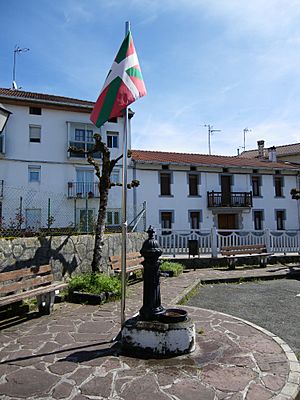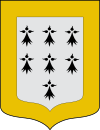Fruiz facts for kids
Quick facts for kids
Fruniz
|
|||
|---|---|---|---|
| Fruniz | |||

Town square
|
|||
|
|||
| Country | Spain | ||
| Autonomous community | Basque Country | ||
| Province | Biscay | ||
| Comarca | Mungialdea | ||
| Area | |||
| • Total | 5.73 km2 (2.21 sq mi) | ||
| Elevation | 45 m (148 ft) | ||
| Population
(2018)
|
|||
| • Total | 545 | ||
| • Density | 95.11/km2 (246.3/sq mi) | ||
| Demonym(s) | Fruiztarra | ||
| Website | http://www.fruiz.net/ | ||
Fruiz (also called Fruniz) is a small, interesting town in northern Spain. It's located in the Basque Country, a special region with its own language and culture. Fruiz is part of the Biscay province. It's a municipality, which means it's a town with its own local government.
Contents
What's in a Name? The Story of Fruiz
The name Fruiz has a cool history! Many places in the Basque Country end with "-iz." Experts like Julio Caro Baroja believe these names come from an old personal name plus a Latin ending. This ending, "-icus," was used to show that a place was owned by a certain person. This idea goes all the way back to the Roman Empire!
For Fruiz, it's thought the name might come from a Latin word like Furius. If you add the "-icus" ending, you get Furicus. A similar word, Furunicus, could be the origin of Frúniz. Furunicus might even have meant "son of Furius."
The town was originally known as Fruniz. In the 1800s, the Royal Spanish Academy made rules for Spanish spelling. This led to the name changing to Frúniz, adding an accent mark. However, in the Basque language, the name kept changing. It lost the "n" sound between the vowels, which is common in old Basque. This is how it became Fruiz.
Today, the official name of the town in Basque is Fruiz. In Spanish, it's often still called Frúniz. In 1994, the local government decided to officially use the Basque name, Fruiz.
A Glimpse into Fruiz's Past
The history of Fruiz goes back a long way, possibly to the late 700s! Legend says that Fortunio Fruniz won a battle in a place called Asturiazaga. After his victory, he ordered a special house to be built there.
The land around Fruiz was very good for farming. Farmers grew important crops like wheat, corn, and beans. The local woods were also useful. They provided great places for cattle to graze and lots of timber for building houses and other structures.
In 1781, an exciting event started in Fruiz: an annual cattle fair! This fair was first held at the chapel of San Lorenzo. Even today, this tradition continues. The fair is now celebrated every year on the second Sunday of August in the Aldai neighborhood. It's a fun time for everyone!
Fun Festivities in Fruiz
Fruiz loves to celebrate! There are four main festivals that the town enjoys throughout the year. These events bring people together for food, fun, and traditions.
San Salvador: The Big Day
- When: August 6th
- What: This is considered the "Big Day" in Fruiz! It's called "San Salvador."
- Highlights: A special meal called "Herry Bazkari" is organized. Everyone is invited to join, whether they live in Fruiz or are just visiting. It's a great way to share a meal and enjoy the community spirit.
Agricultural-Livestock Fair
- When: The second Sunday of August
- What: This fair celebrates the farming and animal-raising traditions of the area.
- Highlights: You can see local farm animals and learn about agricultural products. It's a lively event that connects people to the town's roots.
Sallebante / San Lorenzo
- When: August 10th
- What: This festival honors San Lorenzo.
- Highlights: The celebrations take place at the chapel located in the Barrio Andeko neighborhood. It's a chance for people to gather and celebrate in a beautiful setting.
San Miguel
- When: September 29th
- What: This feast day celebrates St. Michael.
- Highlights: The festivities are held in the Barrio Botiola neighborhood. It's another wonderful opportunity for the community to come together and enjoy local traditions.
How Fruiz is Governed: The 2011 Elections
Like all towns, Fruiz has a local government that makes decisions for its people. The mayor is the head of this government. In 2011, there was an election to choose who would be the mayor and the town council members.
Four different political parties ran in the election:
- EAJ-PNV (Basque Nationalist Party)
- Bildu
- PSE-EE (Socialist Party of the Basque Country – Basque Country Left)
- People's Party (PP)
Here's how the votes turned out:
- EAJ-PNV: They received 165 votes and won 5 councilor seats.
- Bildu: They received 98 votes and won 2 councilor seats.
- PSE-EE: They received 5 votes and did not win any councilor seats.
- People's Party (PP): They also received 5 votes and did not win any councilor seats.
Based on these results, the EAJ-PNV party won the election. This meant they had the most representatives on the town council and their candidate, Ainara Zelaia, became the mayor.
See also
 In Spanish: Frúniz para niños
In Spanish: Frúniz para niños




